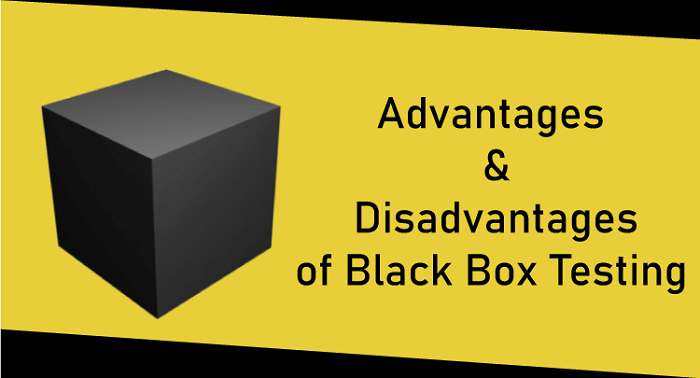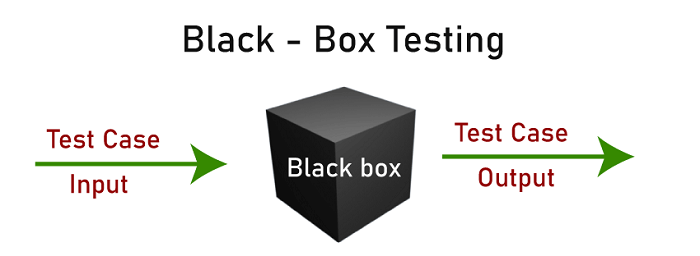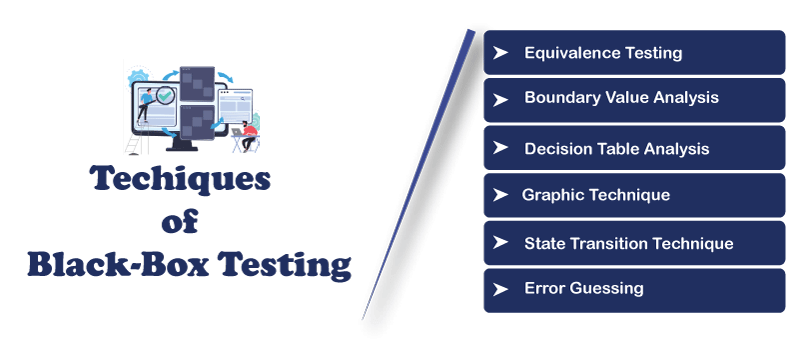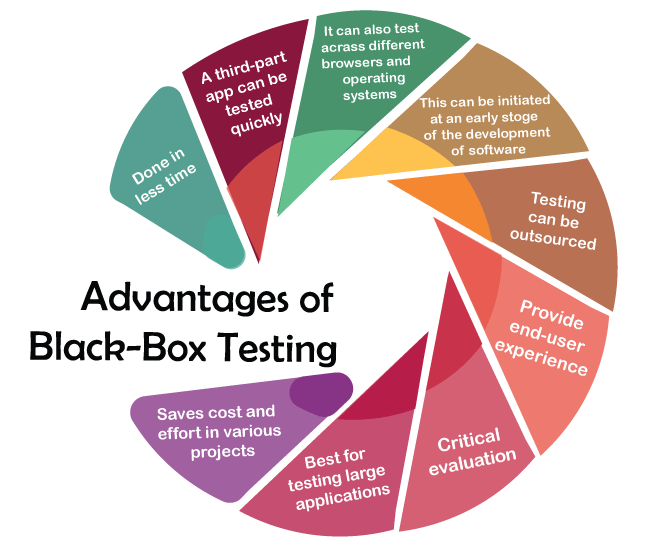Advantages and Disadvantages of Black-box TestingSoftware development is complete when it goes through the testing phase, considered an important phase in SDLC (software development life cycle). 
The testing procedure helps decide the proper functioning of the developed software and ensures software is free from any errors. Software developers or software testers do the testing procedure in two ways a) manually and b) automatically. With the advancement in technologies, the testing procedure has upgraded from manual to automatic. Three types of testing are applied in the testing world: white box testing, black box testing and grey box testing. Today we study black box testing and its advantages and disadvantages. Black box testing is a technique where the coding part remains hidden or in a black box that the tester can't see. In this, the developer tests code without knowing the internal working of the application. Black box testing, also known as functional testing, can quickly identify how the system responds to expected and unexpected user actions, reliability issues, and response time and is applied to all software testing levels. 
Black box testing ensures the system gives proper output to the input because the end user doesn't care how a system is architected or coded; they are just meant to receive an appropriate response to their requests. It is best suited for creating test environments for mobile applications, network applications and third-party software. Even in this testing, it's optional that testers have detailed knowledge of the programing language. Instead, they should understand what the software is supposed to do. The black-box testing process has specific steps that combine & called STLC (software testing life cycle). This own life cycle of black box testing relates to the SDLC of software engineering. STLC steps are:
Types of black box testingFunctional testing All applications' specifications or functional requirements are tested in this type of black box testing. The system functions or actions are tested by providing an input in which the output is further compared with the expected output. Here applications or programs are tested on the user's behalf with different test cases and paths. The black box functional testing software is tested against the specification by checking the output for a given input, also termed verification. There are various kinds of functional testing:
Non-functional testing It is opposite to functional testing as their user functions are tested. Still, in this testing, several non-functional aspects are tested to improve the quality and performance of the application. This testing involves stress testing, compatibility testing, load testing, usability testing, performance testing, scalability testing and stress testing. It includes how software accomplishes an operation, its usability, compatibility with relevant devices and browsers, performance under peak loads and vulnerability to security threats. Regression testing When a system or software inevitably suffers a glitch after an upgrade or patch applied to vulnerabilities called regression, regression testing is the best way to deal with this problem. Testers use regression testing to find any default or degradation in the system or software capabilities or whether a new software version exhibits a regression. This testing is applied on both functional (some feature doesn't perform as expected in the new version) and non-functional (an operation performed in the updated version is working slowly) aspects of the software or system. Some of the tools that perform black box testing
Techniques of black box testing
Advantages of black box testing
a) Done in less time Compared with other approaches, the simplified testing technique takes less time to test the software because black box testing requires less preparation. There is no need to create test scripts for testers, and they don't know programming languages. Knowledge of the subject or testing is enough to judge how specific bugs will be caught during testing; therefore, it is less time-consuming. b) A third-party app can be tested quickly. Some third-party software or application can only be tested with effort because creating a complete test environment is impossible. Black box testing can be conducted with the available details and gives an insight into how well the product works. c) It can also test across different browsers and operating systems. Black box testing is not only bounded to web applications but can be applied to mobile applications or other software where only documentation is available. Due to this feature, testing is functional over different browsers and operating systems. A tester testing the mobile application requires an internet connection (a local testing environment couldn't be created). This technique is the best option as it doesn't require an account on the relevant app store like Google, Apple etc. d) This can be initiated at an early stage of the development of software Before completion of the functional specification, the test cases can be designed efficiently in black box testing. Here tester shouldn't have to wait for the code completion and can conduct testing during the development phase due to less lag between when a bug is introduced and spotted. e) Testing can be outsourced. As we know, in black box testing, testers don't need to know program code; therefore, this testing doesn't require experts. Hence black box testing can be conducted by non-technical testers who can be easily outsourced. f) Provide end-user experience All the tests in black box testing are conducted from the end-user perspective. g) Critical evaluation Critical issues and functionality gaps are discovered in black box testing without having previous knowledge of the internal working of the system. h) Best for testing large applications This technique is well-designed for large-scale application testing. It is not a browser of a system; that's why it doesn't need a specific environment and mainly focuses on the input and output of software applications (based on software requirements). i) Black box testing is unbiased. In black box testing tester doesn't know the internal coding of the software due to the designer and tester working independently. This makes black box testing unbiased and best for testing. j) It is the user's perspective. In black box testing, the testers have access to different information than developers as they pay attention to the program's functionality. With this, they can express concerns or share comments from the user's perspective. k) It is best for software specification. In this testing, testers need to access requirement and specification documents which can help identify the ambiguous language in the documentation. The product team considers testers' results and comments to create a better specifications for end users. l) Black box testing has a low cost. In black box testing, testers don't need to have programming knowledge. That's why this testing consumes less time and is one of the cheaper testing processes. m) Saves cost and effort in various projects Black box testing is the best testing approach as it saves the testing cost and efforts of any large or small scale projects with its various features like it do not depend on system or application configuration, doesn't need technical testers all the time, find the bugs and faults before completion of the code that saves time and money of the business. Disadvantages of black box testingYet advantageous testing can harm the working, workers, software or the software industry. Let's learn and understand the negative aspects of testing. a) No prioritization of bugs Black box testing usually identifies the faulty modules but does not explain in detail whether they meet the requirement. Testers must have deep knowledge of specific bugs because some are caused by incorrect implementation, and some need to be noticed during testing and QA services. Prioritizing bugs is difficult, as in black box testing, accessing the code or documentation is impossible. Access is necessary to know what has been done correctly and what hasn't. b) Black box testing doesn't provide a detailed explanation Black box testing is best suited when the testing detail is not asked, i.e. how can you test detailed procedure is not asked. It is useful when there are no undocumented requirements occurs. c) Overestimated results Due to unclear functional specifications, black testing provides overestimated results of the testing process and can't be used for complex testing segments of code. d) Designing test cases is challenging. As black box testing doesn't have a clear functional specification, it creates difficulty for testers to create test cases. e) It needs to provide a complete picture. Black box testing provides you with the outer knowledge and makes assumptions based on that. Due to this, black box testing can be used with other testing approaches like white box testing and grey box testing. Conclusion: After this, we can conclude that black box testing, one of the software testing techniques, can be conducted by anyone who wants to test the software because coding (code) knowledge is not required in this technique. This technique is best suitable for large applications because this focus is given to testing. It also validates the behaviour and functionality of the software. With the advantages and disadvantages of black box testing, we can understand this technique to a great extent.
Next TopicAdvantages and Disadvantages of BPO
|
 For Videos Join Our Youtube Channel: Join Now
For Videos Join Our Youtube Channel: Join Now
Feedback
- Send your Feedback to [email protected]
Help Others, Please Share










